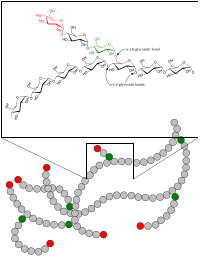Glycogen Storage Disease Type Iv

Glycogen storage disease type IV is a form of glycogen storage disease, which is caused by an inborn error of metabolism. It is the result of a mutation in the GBE1 gene, which causes a defect in the glycogen branching enzyme. Therefore, glycogen is not made properly and abnormal glycogen molecules accumulate in cells; most severely in cardiac and muscle cells. The severity of this disease varies on the amount of enzyme produced. Glycogen Storage Disease Type IV is autosomal recessive, which means each parent has a mutant copy of the gene but show no symptoms of the disease. It affects 1 in 800,000 individuals worldwide, with 3% of all Glycogen Storage Diseases being type IV.
Human pathology
It is a result of the absence of the glycogen branching enzyme, which is critical in the production of glycogen. This leads to very long unbranched glucose chains being stored in glycogen. The long unbranched molecules have a low solubility which leads to glycogen precipitation in the liver. These deposits subsequently build up in the body tissue, especially the heart and liver. The inability to breakdown glycogen in muscle cells causes muscle weakness. The probable end result is cirrhosis and death within 5 years. In adults, the activity of the enzyme is higher and symptoms do not appear until later in life.
Variant types
Fatal perinatal neuromuscular type
- Excess fluid builds up around fetus and in the fetus’ body
- Fetus have condition called akinesia deformation sequence
- Causes decrease in fetal movement and stiffness of joints after birth
- Infants have low muscle tone and muscle wasting
- Do not survive past newborn stage due to weakened heart and lungs
Congenital muscular type
- Develops in early infancy
- Babies have dilated cardiomyopathy, preventing heart from pumping efficiently
- Only survive a few months
Progressive hepatic type
- Infants have difficulty gaining weight
- Develop enlarged liver and cirrhosis, that is irreversible
- High BP in hepatic portal vein and buildup of fluid in abdominal cavity
- Die of liver failure in early childhood
Non-progressive hepatic type
- Same as progressive, but liver disease is not as severe
- Do not usually develop cirrhosis
- Usually show muscle weakness and hypotonia
- Survive into adulthood
- Life expectancy varies on severity of symptoms
Childhood neuromuscular type
- Develops in late childhood
- Has myopathy and dilated cardiomyopathy
- Varies greatly
- Some have mild muscle weakness
- Some have severe cardiomyopathy and die in early adulthood
Diagnosis
An assay of α 1,4 1,4 glucan transferases.
Terminology
It is also known as:
- Glycogenosis type IV
- Glycogen branching enzyme deficiency
- Polyglucosan body disease
- Amylopectinosis
The eponym "Andersen's disease" is sometimes used, for Dorothy Hansine Andersen.
Mutations in GBE1 can also cause a milder disease in adults called adult polyglucosan body disease.
In animals
The form in horses is known as glycogen branching enzyme deficiency. It has been reported in American Quarter Horses and related breeds.
The disease has been reported in the Norwegian Forest Cat, where it causes skeletal muscle, heart, and CNS degeneration in animals greater than 5 months old. It has not been associated with cirrhosis or liver failure.